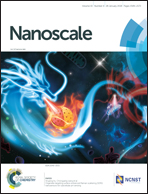High-Q and highly reproducible microdisks and microlasers†
Abstract
High quality (Q) factor microdisks are fundamental building blocks of on-chip integrated photonic circuits and biological sensors. The resonant modes in microdisks circulate near their boundaries, making their performances strongly dependent upon surface roughness. Surface-tension-induced microspheres and microtoroids are superior to other dielectric microdisks when comparing Q factors. However, most photonic materials such as silicon and negative photoresists are hard to be reflowed and thus the realizations of high-Q microdisks are strongly dependent on electron-beam lithography. Herein, we demonstrate a robust, cost-effective, and highly reproducible technique to fabricate ultrahigh-Q microdisks. By using silica microtoroids as masks, we have successfully replicated their ultrasmooth boundaries in a photoresist via anisotropic dry etching. The experimentally recorded Q factors of passive microdisks can be as large as 1.5 × 106. Similarly, ultrahigh Q microdisk lasers have also been replicated in dye-doped polymeric films. The laser linewidth is only 8 pm, which is limited by the spectrometer and is much narrower than that in previous reports. Meanwhile, high-Q deformed microdisks have also been fabricated by controlling the shape of microtoroids, making the internal ray dynamics and external directional laser emissions controllable. Interestingly, this technique also applies to other materials. Silicon microdisks with Q > 106 have been experimentally demonstrated with a similar process. We believe this research will be important for the advances of high-Q micro-resonators and their applications.



 Please wait while we load your content...
Please wait while we load your content...